A Look Back at
Explore the Queen City’s Past
Building BANGOR

VISIT THE SITES THAT MAKE BANGOR ARCHITECTURE
SO UNIQUE & SPECIAL

Sifting through HISTORY
FIRES, GANGSTERS & DIGNITARIES: DISCOVER WHAT’S SHAPED OUR CITY
Who are YOU?
PRO TIPS ON TRACING YOUR OWN HISTORY



SPECIAL ADVERTISING SECTION OF THE BANGOR DAILY NEWS • 2023

Publisher RICHARD J. WARREN Advertising Sales LAURIE CATES lcates@bangordailynews.com JEFF ORCUTT jorcutt@bangordailynews.com Editor & Art Director AMY ALLEN aallen@bangordailynews.com Creative Services Manager CORALIE CROSS Creative Services CALLIE PICARD Cover Paper Art Amy Allen To advertise in our next edition, please call 990-8134 or email advertising@bangordailynews.com © 2023 Bangor Daily News. All rights reserved. Reproduction in whole or in part is prohibited without express written consent. Requests for permission to copy, reprint, or duplicate any content should be directed to advertising@bangordailynews.com bangordailynews.com PO Box 1329 Bangor, ME 04402-1329 To subscribe, call 990-8002 Contents bangordailynews.com BANGOR DAILY NEWS / 1 02 A LOOK BACK AT BANGOR FROM FIRES TO GANGSTERS AND DIGNITARIES, BANGOR HAS A WILD PAST. EXPLORE THE QUEEN CITY’S VIBRANT HISTORY. 09 TRACE YOUR ROOTS DIG INTO YOUR OWN HISTORY WITH THESE HANDY LOCAL GENEALOGICAL RESOURCES. 10 BUILDING BANGOR TAKE A DEEPER DIVE INTO THE ICONIC ARCHITECTURE YOU PASS BY EVERY DAY. 10 DID YOU KNOW THE BANGOR HISTORICAL SOCIETY IS SHARING THE FASCINATING HISTORY BEHIND SOME OF THE CITY’S MOST RECOGNIZABLE BUILDINGS.
A Look Back at


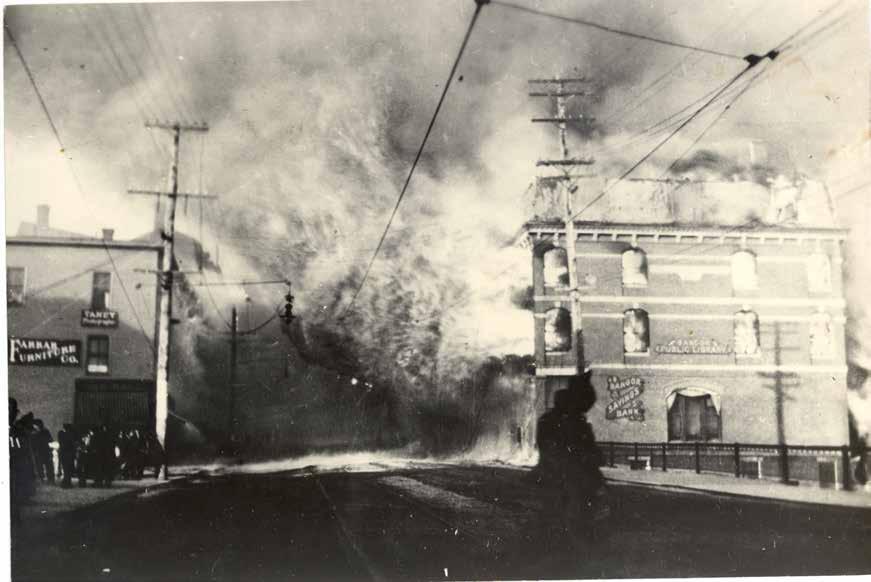


2 / A LOOK BACK AT BANGOR 2023
(Top) The hayshed where the 1911 fire started, looking through the burned building towards Union Station across the Kenduskeag Stream.
(Below) The Bangor Savings Bank building during the 1911 fire. The building once housed the Bangor Public Library and the Bangor Historical Society on the upper floors.
COURTESY OF THE BANGOR HISTORICAL SOCIETY
FIRES,
GANGSTERS, & DIGNITARIES:
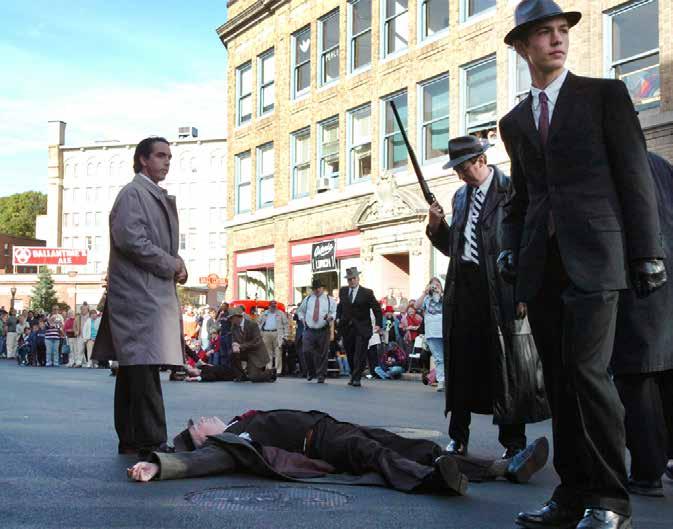
EXPLORE THE QUEEN CITY’S VIBRANT HISTORY

 BY ANNE GABBIANELLI
BY ANNE GABBIANELLI

As I sift through the yellowed, fragile, bound pages of the 1938 Bangor Daily Commercial newspaper, I’m reminded of the value of these treasured types of documents. For example, one page shared the good news that Bangor’s Godfrey Field is being eyed for an Army Air Base, another spoke of a blizzard that ripped through at Thanksgiving time, and there are numerous ads, some promoting whole milk — three tall cans for 23 cents, and fur coats priced just under $70. Bangor is unique in its long and varied history. How could you top the story that gangster Al Brady was gunned down by FBI agents on Central Street in 1937, leaving his body straddling the trolley tracks? In 1935, Brady, part of a criminal trio, was the object of one of the greatest manhunts in the history of American crime. That manhunt ended in Bangor.

The city’s history and landscape were forever altered by the great fire of 1911, a fire so spectacular that it could be seen from Belfast. The city was left in ruins.
 (Top) Historian Richard Shaw, as Al Brady, during a 2007 shootout reenactment. BDN FILE PHOTO
(Above) The 1965 Easter Parade on Main Street, Bangor.
(Right) Bangor’s Main Street in 1964.
PHOTOS COURTESY OF RICHARD SHAW
(Top) Historian Richard Shaw, as Al Brady, during a 2007 shootout reenactment. BDN FILE PHOTO
(Above) The 1965 Easter Parade on Main Street, Bangor.
(Right) Bangor’s Main Street in 1964.
PHOTOS COURTESY OF RICHARD SHAW



 (Clockwise from left) John F. Kennedy campaigns at Bass Park on Sept. 3, 1960. First Lady Eleanor Roosevelt at a downtown Bangor reception in the summer of 1941. Lightning over Union Station, circa 1939. Union Station, now the site of the Penobscot Plaza Shopping Center, was demolished after railroad service stopped in 1960.
BDN FILE PHOTOS COURTESY OF RICHARD SHAW
(Clockwise from left) John F. Kennedy campaigns at Bass Park on Sept. 3, 1960. First Lady Eleanor Roosevelt at a downtown Bangor reception in the summer of 1941. Lightning over Union Station, circa 1939. Union Station, now the site of the Penobscot Plaza Shopping Center, was demolished after railroad service stopped in 1960.
BDN FILE PHOTOS COURTESY OF RICHARD SHAW
“The fire not only destroyed so many of the buildings showcasing our lumbering heritage, but so many large portions of the city archives as well,” said Matt Bishop, curator and operations manager of the Bangor Historical Society.
Bangor historian and writer Richard Shaw claimed that while the fire “destroyed 55 acres of downtown real estate, it failed to quell the Queen City’s spirit.”


Bishop reflected on Bangor’s iconic notes in history.


“Most people will say lumber, Al Brady, and Stephen King. Personally I feel that it is our location,” he said. “Being that crossroads of eastern, northern, and central Maine, where we are at the head of tide on the Penobscot [River], the ships could get to this point for travelers and goods as well as the lumber coming downriver.”



When it was incorporated as a town in 1791, Bangor was a trading and sawmill village that grew to become the “Lumber Capital of the World” by the mid-19th century. Many of the lumber barons built elaborate homes, and several substantial churches were built, adding to the beauty of the city. By the 1860s, it was known as the “The Queen City of the East.” Some tend to believe the city got its nickname because of the strand of lights crowning the Thomas Hill Standpipe. Yet, the standpipe, built in 1897, did not add lights to its crown until 1912.

Running rum was a big business out of Bangor’s port, despite municipal efforts to curtail the activity. In 1853, the publication Bangor Democrat quoted a Boston newspaper: “There has been enough rum sent hence to Bangor lately to give even river water a contraband tincture.”
In 1861, the Second Maine Infantry marched off to war with music from the Bangor Band, which was incarnated in 1859 and still provides entertainment today.
The 1880s saw the construction of Morse’s Bridge, a covered bridge spanning the Kenduskeag Stream, and the creation of the Tarratine Club, a social club of elite local businessmen, which named former U.S. Vice President Hannibal Hamlin as its first president. The club building still exists today on Park Street and includes a restaurant.
In the early 1900s, Bangor saw the construction of what is now the Dorothea Dix Psychiatric Center, frequent appearances by Barnum and Bailey’s Greatest Show on Earth, bridge construction over the Penobscot River, and








































































































bangordailynews.com BANGOR DAILY NEWS / 5
the steamer “City of Bangor,” which sailed three times a week.

The military called Bangor home, with significant development near the location of the current Army and Air National Guard bases. When Dow Army Air Field, later called Dow Air Force Base, closed after nearly 30 years of operation, Shaw said some predicted Bangor would go “bust.”

“That also failed to quell the Queen City’s spirit,” he added.






Many dignitaries traveled through Bangor, including President Ulysses S. Grant, who spent an overnight at the Bangor House in 1871. The Bangor House was also a backdrop for Presidents Theodore Roosevelt and William Howard Taft, who delivered speeches in the early 1900s. In 1909, Adm. Robert E. Peary visited Bangor on his return from the North Pole, and Amelia Earhart visited the airport in 1934.
The Opera House that burned in 1914 was rebuilt and opened six years later with entertainers like Jack Benny. If you saw pictures after that fire was quenched, you’d be reminded of the January 2004 blaze at the Masonic Temple Association building. Nearly 5 million gallons of water encased the building, reminiscent of the ice-sealed Opera House. Down the road in 1959, the iconic Paul Bunyan statue was erected, never wavering from his spot along Main Street all these years.


In sifting through “Headlines in History: 100 Years of Front Page News” by the Bangor Daily News, I was taken back to 1991, when hundreds of soldiers touched down on American soil after months in the Middle East. They experienced a warm Maine welcome at Bangor International Airport. The tradition continued, leading to a Troop Greeters Museum at the airport and a 2009 documentary featuring several dedicated senior citizen troop greeters.
Want More Bangor History?


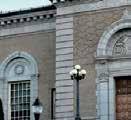



In addition, the Friends of the Bangor Public Library are selling a 2023 calendar titled “Downtown Bangor: Then and Now.” The calendar is $10 and available at the library and select Bangor businesses.
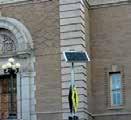
PAST & PRESENT PAST & PRESENT BANGOR Richard R. Shaw BANGOR Richard R. Shaw 10/18/22 12:52 PM
(Above) The view down the west side of Bangor’s Main Street’s circa 1965,
BDN FILE PHOTOS COURTESY OF RICHARD SHAW
(Right) The Bijou Theater on Exchange Street in the 1960s. The theater was demolished in 1974.
Bangor
new
comes out this April
Publishing. The book offers a collection of
the years.
Pick up
historian Richard Shaw’s
book, “Bangor, Past & Present,” which
from Arcadia
photos, featuring local landmarks through
Another event for the history books occurred in 1992, when Bangor hosted its first ever Transatlantic balloon race. I recall broadcasting live in the wee hours of the morning as five balloons departed from Bass Park.



“The more I wrote about the Queen City, I grew to view it as a nearly unique community in all of America,” Shaw said. “There was the naughty side, the timber barons, the mansions, the hovels. The river boats, the log drives. Bangor’s history has definitely been stellar since its incorporation as a city in 1834. We have survived the end of the lumber boom in the 1870s, fires, floods, the closing of an air base, and still we look to the future. Our 19th-century dream of being a force to reckon with is finally coming true, not with a huge population, but with prestige and respect for diversity.”












After researching more about Bangor’s history, it’s clear Henry David Thoreau was correct following his 1846 visit when he described Bangor as a “star on the edge of night.”




















bangordailynews.com BANGOR DAILY NEWS / 7
Trace Your Roots
DIG INTO YOUR OWN HISTORY WITH THESE LOCAL RESOURCES
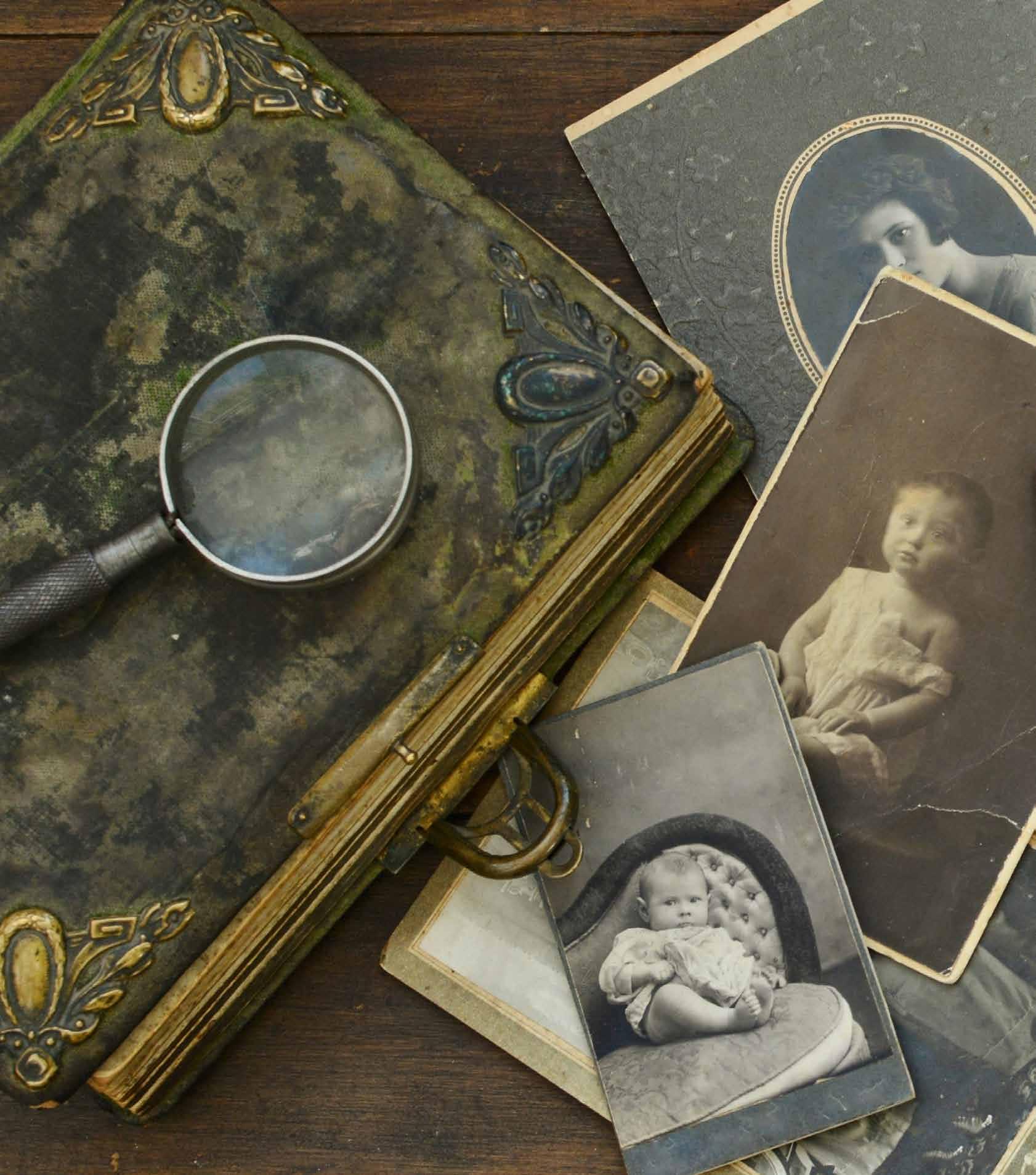 BY NANCY BATTICK
BY NANCY BATTICK
8 / A LOOK BACK AT BANGOR 2023
Terms such as pedigree charts, twice-removed cousins, and the thought of researching online may send some people into panics. If you live in Greater Bangor, you can relax, because there are some wonderful resources at your fingertips, and they are all free.
GATHER KNOWN INFO
First, start by gathering all the information you know about your family: names, dates, places. This will help provide clues for further research. You can add family “stories,” but take them with a large grain of salt until proven. A relative swore we descended from Nathan Hale, but since he never married nor sired known children, it’s just a myth. Don’t try to link to a famous person; just begin with yourself.
ASK THE EXPERTS
Start your quest at the Bangor Public Library. On the second floor, you’ll find an extensive genealogy department staffed by expert genealogists. The staff will assist you in any way they can and point you in the right directions. If you’re unsure how to operate a computer, the library staff can help you learn. Ancestry Library is free online, and the New England Historic Genealogical Society’s American Ancestors website is also available. On these you can access censuses, town and county vital records, draft records, and numerous other databases.
The library also has a great selection of city directories, cemetery records, family histories, some Bangor church records, Penobscot County records, yearbooks, and a wide selection of genealogical publications. The Bangor Public Library can also tap into catalogs for other research libraries in Maine through the University of Maine System (URSUS).
If Bangor doesn’t have it in their collection, they may be able to help you find out where a record is housed or sometimes a book may be obtained through interlibrary loan. This is a tremendous resource for would-be family genealogists and historians.


A few blocks away, the Bangor Maine FamilySearch

Center is on Grandview Avenue. This resource is courtesy of the LDS Church and is staffed by volunteers. The center is not open every day, and it’s always wise to call ahead to be sure they aren’t closed because of weather or illnesses. The center offers an extensive microfiche and microfilm collection, books primarily covering Maine and the New England states, and access to databases including Findmypast, Fold3.com, MyHeritage, Ancestry.com, and many others to aid you in searching for your family records. They also offer re source courses. You can call the center at (207) 947-7677.
There are also other sources in Greater Bangor, including the Fogler Library at the University of Maine and the Bangor Historical Society to name but a few. The Penobscot County Genealogical Society offers free programs, and they meet in-person or over video conferencing from the Bangor Public Library. Often talking to other genealogists will be of great help, especially if they’ve been researching for years. You might even meet cousins you didn’t know you had.
ONE STEP AT A TIME
Don’t feel overwhelmed. We all began our research with tiny baby steps. Don’t be discouraged if you can’t immediately trace family back to 1600. It takes time. Also, beware of the thousands of online trees submitted by other researchers. Don’t trust blindly. It’s much better to take your time and enjoy the journey of finding your roots, as Professor Henry Louis Gates said. Good luck, have fun, and I wish you all the best in your genealogical journey.
Nancy Battick is a past president of the Maine Genealogical Society, and has been researching, teaching, and writing about genealogy for more than 30 years. She writes a twice-monthly genealogy column called The Family Discoverer, which can be found at TheCounty.me website, FiddleheadFocus.com, and in The Piscataquis Observer, The Star Herald, the Houlton Pioneer Times, the Aroostook Republican, and the St. John Valley Times.
bangordailynews.com BANGOR DAILY NEWS / 9
SOONER OR LATER we feel the urge to learn more about our ancestors. These days, DNA tests abound, but they don’t answer questions about your family history itself. But how to start?















10 / A LOOK BACK AT BANGOR 2023
Building Bangor
CONNECTING TO HISTORY THROUGH ICONIC ARCHITECTURE
BY STEPHANIE BOUCHARD
The historic Trinity Church in New York City is an architectural icon. The Gothic Revival structure was built by architect Richard Upjohn from 1839 to 1846. What many locals may not realize, however, is that before Trinity Church, Upjohn designed another church right here in Bangor. Every day, people walking, biking, and driving through the streets of Bangor are passing by buildings that have stories — and amazing ones at that. The Bangor Historical Society has been sharing those stories since 2014 through a “Did You Know” series on its Facebook page, where they post photos and tidbits about area homes, buildings, and people significant to Bangor history. The old photos never fail to generate interest, according to Matt Bishop, curator and operations manager of the historical society.
Bangor Public Library
DID YOU KNOW: On Jan. 17, 1912 the cornerstone was laid for the “new” Bangor Public Library on Harlow Street.

The previous building had been located on State Street where Bangor Savings Bank is today, but was lost in the Great Fire of 1911. According to the Bangor Public Library, after the fire, a Boston architectural firm drew up plans for an educational center in Bangor, including a new high school building and public library. The “old” Bangor High School on Harlow Street is now apartments.
DID YOU KNOW THESE FACTS & PHOTOS ARE COURTESY OF THE BANGOR HISTORICAL SOCIETY?
LEARN MORE ABOUT THE BANGOR HISTORICAL SOCIETY ON PAGE 13, AND FIND MORE “DID YOU KNOW” HISTORICAL FUN FACTS ON THEIR FACEBOOK PAGE
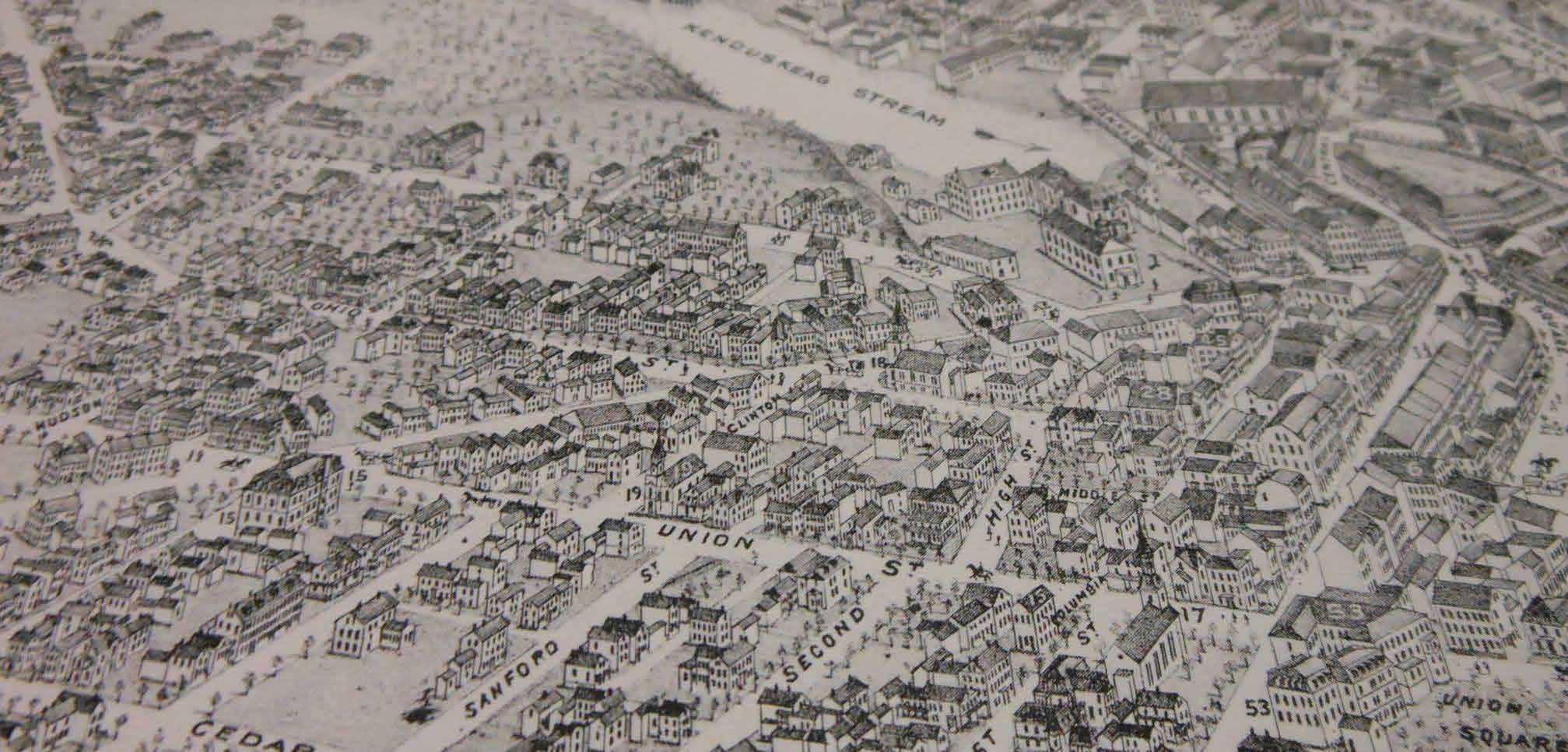
bangordailynews.com BANGOR DAILY NEWS / 11
St. John’s Episcopal Church
DID YOU KNOW: The beautiful St. John’s Episcopal Church on French Street in Bangor that stands today was designed by the grandson of its original architect. In the 1830s, Richard Upjohn designed the original wood structure (right photo) that burned in the Great Fire of 1911. When the congregation rebuilt they hired Hobart Upjohn, Richard’s grandson, to design the new, stone structure (left photo) that stands today.


“People just love looking at old photos,” Bishop said.
People often share their own memories of places on the Bangor Historical Society’s Facebook page, such as a child’s thrill riding the escalator at Freese’s Department Store on Main Street in Bangor. And sometimes learn something they didn’t know about the house where they currently live or a building they pass by every day on their way to work, like St. John’s Episcopal Church on French Street.
People often share their own memories... such as a child’s thrill riding the escalator at Freese’s Department Store on Main Street in Bangor.
St. John’s Episcopal Church is a stone replica of a wood structure designed by none other than Richard Upjohn, the architect of New York City’s famous Trinity Church. Upjohn’s church was built in the mid-1830s, just before he began working on Trinity Church. His wood version of St. John’s was destroyed in Bangor’s 1911 fire. His grandson, Hobart Upjohn, built the stone replica from 1912 to 1918 that stands today.
Isaac Farrar Mansion
DID YOU KNOW: The Isaac Farrar Mansion on Union Street was built from 1843-1845 by lumberman Isaac Farrar as a present to his wife. It was designed by Richard Upjohn. The mahogany inside the Isaac Farrar Mansion was imported from Santo Domingo and the slate from Bangor, Wales.

Later, Charles B. Sanford, son of Capt. Menemon Sanford, married his second wife, Marie French, in Bangor in 1860, and they moved into the Farrar Mansion. By 1873, he was proprietor of the Independent Line of Steamers.
Marie died in 1874 in Brooklyn, N.Y. Charles died in Searsport in 1896; he is buried in Mt. Hope Cemetery.
12 / A LOOK BACK AT BANGOR 2023
Thomas A. Hill House
DID YOU KNOW: The Thomas A. Hill House was built in 1835 for lawyer Thomas A. Hill. Like the Farrar Mansion across Union Street, the Hill House was designed by architect Richard Upjohn. Upjohn would become one of the country’s best-known architects and founder of the American Association of Architects.

Hill lived in the house until 1845 when future Bangor Mayor Samuel Dale and his family moved in. Eventually the house would be deeded to the Sons of Union Veterans/Grand Army of the Republic. Years later, the GAR would deed the property to the Bangor Historical Society, which still calls the Hill House home today.
About the Bangor Historical Society


The Hill House now protects and houses the Bangor Historical Society’s collections, as well as serving as a museum and function space. The Society is in the middle of a multi-year renovation project, including working on the exterior portico, interior ceilings, and bringing back a period-appropriate fence to the lawn. You can show your support by becoming a member or with a one-time donation. Visit bangorhistoricalsociety.org for details.

bangordailynews.com BANGOR DAILY NEWS / 13
Bangor Opera House
DID YOU KNOW: Bangor’s first Opera House opened in 1882. Designed by architect Arthur Vinal, it was host to Ethel Barrymore, Oscar Wilde, and countless other famous performers. The structure survived the Great Fire of 1911 only to burn in 1914. The lot was purchased by Joseph P. Bass in February 1919 with promises to rebuild. The building was acquired by the Penobscot Theatre Company in 1997, and remains its home today.

St. John’s was the first Gothic church Richard Upjohn designed, but it wasn’t his first commission in Bangor. He also designed the Thomas A. Hill House, now home to the Bangor Historical Society, and the Isaac Farrar Mansion, owned by the YMCA, both on Union Street.

Bangor Historical Society’s posts featuring photos of historic buildings began as a way to engage with people through social media and to show off the massive number of historical photographs the society has in its collection, Bishop said. But they also connect people to Bangor’s history through the lens of its architecture.
St. John’s, for example, illustrates the growing wealth of the city as a booming lumber capital. The destruction of the wood church in the fire of 1911 is a reminder of a major disaster and the rebuilding of the church in stone is an example of lessons learned.
Much like a tree’s growth rings, you can look at Bangor’s different neighborhoods and see how the city grew, with each style of home popular at a given time giving way to the next architectural trend.
Wheelwright Block
DID YOU KNOW: The Wheelwright Block (now home to Mexicali Blues) was built in 1859 and a survivor of the Great Fire of 1911 and urban renewal. It was originally home to clothiers Wheelwright and Clark. The business made uniforms for Civil War soldiers

All Souls Congregational Church
DID YOU KNOW: All Souls Congregation Church has — by one name or another — been on the corner of Broadway and State since 1821. The current building is the third. After the Great Fire, two downtown Bangor churches combined to create All Souls. The current building actually used what it could from the buildings that had been destroyed, and is evidenced by the different colored stone on the outside of building.
French Street House
DID YOU KNOW: This Arts and Crafts-style house on French Street was built in 1915. It was designed by Bangor architect Victor Hodgins, and the first residents were brothers Eugene H. and Charles L. Dakin and their sister, Florence. Eugene Dakin is best known as an owner of Dakin’s Sporting Goods on Central Street from from 1920-1924. Dakin’s is the same shop where Al Brady later came and met his end in 1937. This unique home still exists today.

John A. French Home
DID YOU KNOW: This home on the corner of Broadway and Cumberland streets was originally designed by Charles G. Bryant for John A. French. It was built from 1833-1834.
While the home was built for French, it was Col. Henry Little who lived there longer. Little was a veteran of the War of 1812 who moved to Bangor in 1836. He moved into the house sometime between 1844 and 1845. Col. Little was the founder and owner of Henry Little & Co., a nursery specializing in fruit trees, which was very successful and widely recognized.

Benjamin H. Mace House
DID YOU KNOW: The Benjamin H. Mace House located on State Street was built from 1867-1868. It became the first building of Bangor General Hospital in 1892. We now know Bangor General Hospital as Northern Light Eastern Maine Medical Center, and if you look carefully enough you can still see the original Mace House in the middle of the expansive campus. The gray stone used in its construction was taken from the stone ledge on the Penobscot River where the house stands.

bangordailynews.com BANGOR DAILY NEWS / 15
The Tarratine Club
DID YOU KNOW: The Tarratine Club, Bangor’s “premier social club,” held its first meeting in 1884. The Tarratine Club was founded by Hannibal Hamlin and other Bangor gentlemen. The club was a popular place to gather to play cards and enjoy cocktails. The group was very active, and in 1907 built the building on Park Street that bears its name.
Nichols Block
DID YOU KNOW: Exchange Street was once the center of the Bangor social scene, filled with hotels and bars. The Nichols Block building on Exchange Street was designed by Wilfred Mansur and built in 1892. It survived both the Great Fire and urban renewal.

First National Bank was located on the ground floor of the Nichols Block on the corner of Exchange and York Streets. Upstairs is an event space that today still remains and is now home to the Bangor Arts Exchange, Bangor Symphony Orchestra, Launchpad, and others.


To get a flavor of the history all around you, check out these photos and the stories behind them that have been shared by the Bangor Historical Society. You can also check out the historical society’s Facebook page to see posts of historic homes and buildings and learn their histories. The historical
society also has a video presentation that’s an adaptation of its architectural walking tour. Look for that in the videos section of the society’s Facebook page.
If you’re interested in learning about the history of your own home or business building, Bishop said, you may be able to find information through your local historical society by researching the deed at your county’s Registry of Deeds and by looking through old city directories at the library.
16 / A LOOK BACK AT BANGOR 2023
Much like a tree’s growth rings, you can look at Bangor’s different neighborhoods and see how the city grew, with each style of home popular at a given time giving way to the next architectural trend.
The Bijou
DID YOU KNOW: The Bijou Theatre graced Exchange Street from 1912 until its demise during urban renewal in 1974.

When the Bijou opened on April 18, 1912, it was called “one of the finest movie houses in New England.”
This image of The Bijou was taken looking down Exchange Street towards the river. The blocks along the right-hand side are no longer there. The Judicial Center and the Camden National Bank buildings are in that space today.

See page 6 for a picture of The Bijou in the 1960s.


bangordailynews.com BANGOR DAILY NEWS / 17
Freese’s
DID YOU KNOW: Langdon Freese was just 23 years old when he rented a storefront on Main Street. His little shop had only one window but within a year it would double in size. In 1907, he presided over the grand opening of Freese’s Department Store, which occupied the space that’s now home to the Maine Discovery Museum.
In the 1930s photo at right, Freese’s Department Store is all lit up for the Winter Carnival and Food Fair held each year in February. The first fair took place in February 1911. The event was designed to showcase the gadgets and conveniences available because of electricity. Downtown businesses strung lights for the celebration and the end result was not just beautiful, but provided an added level of security to the previously dimly lit streets. The city left the lights up. The result? An increase in downtown shopping and theatre going, creating a “new economy” for a city feeling the downturn of the slowing lumbering and maritime industries.

Norumbega Hall
DID YOU KNOW: When it first opened in 1855, Norumbega Hall was Bangor’s marketplace — much like Quincy Market in Boston. Norumbega Hall was a brick structure on a granite foundation on an island in the middle of the Kenduskeag Stream between Franklin and Central Streets. It had 14 stalls for meat and grocery vendors. Its second story held a grand hall with seats for more than 2,500.

Ralph Waldo Emerson spoke at Bangor’s Norumbega Hall in 1864. It was a return to the Queen City for the author and orator. He had served as interim Pastor of the Unitarian Church (Union Street Brick Church) in 1834.
In 1872, author Harriett Beecher Stowe appeared at Bangor’s Music Hall, which was on the lower level of Norumbega Hall, to do a reading of her works.
Norumbega Hall was destroyed in the Great Fire of 1911, and was replaced by a park-like walkway that is still enjoyed today.

18 / A LOOK BACK AT BANGOR 2023
















 BY ANNE GABBIANELLI
BY ANNE GABBIANELLI


 (Top) Historian Richard Shaw, as Al Brady, during a 2007 shootout reenactment. BDN FILE PHOTO
(Above) The 1965 Easter Parade on Main Street, Bangor.
(Right) Bangor’s Main Street in 1964.
PHOTOS COURTESY OF RICHARD SHAW
(Top) Historian Richard Shaw, as Al Brady, during a 2007 shootout reenactment. BDN FILE PHOTO
(Above) The 1965 Easter Parade on Main Street, Bangor.
(Right) Bangor’s Main Street in 1964.
PHOTOS COURTESY OF RICHARD SHAW



 (Clockwise from left) John F. Kennedy campaigns at Bass Park on Sept. 3, 1960. First Lady Eleanor Roosevelt at a downtown Bangor reception in the summer of 1941. Lightning over Union Station, circa 1939. Union Station, now the site of the Penobscot Plaza Shopping Center, was demolished after railroad service stopped in 1960.
BDN FILE PHOTOS COURTESY OF RICHARD SHAW
(Clockwise from left) John F. Kennedy campaigns at Bass Park on Sept. 3, 1960. First Lady Eleanor Roosevelt at a downtown Bangor reception in the summer of 1941. Lightning over Union Station, circa 1939. Union Station, now the site of the Penobscot Plaza Shopping Center, was demolished after railroad service stopped in 1960.
BDN FILE PHOTOS COURTESY OF RICHARD SHAW



































































































 BY NANCY BATTICK
BY NANCY BATTICK












































